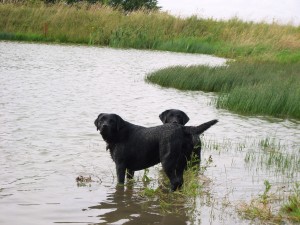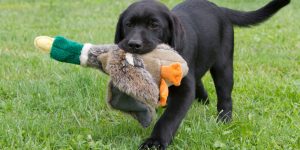The Labrador Retriever
The Labrador retriever is one of our favourite breeds and we have plenty of carers who have a special place in their hearts for Labradors. In our series of breed profiles, Holidays4Dogs takes a look at this much-loved and popular companion.
History
Admired the world over, the Labrador dog originated in Newfoundland over 200 years ago. They worked alongside fishermen, helping to pull in nets and retrieving ropes. They were originally known as ‘St Johns’ dogs because of the area of Newfo undland, from which they came.
undland, from which they came.
However, it is not known what sort of dogs originally made up this breed. Some believe the Labrador’s ancestors were a mix of Irish, English and Portuguese working-type dogs.
They were also often referred to as the ‘Lesser Newfoundland’. The smaller St Johns dogs were crossed with Mastiffs, which resulted in the much larger Newfoundland-type dog we see today.
During the early 19th Century Poole Harbour, in England, was a major port for the Newfoundland fishing trade. Many of these dogs were brought to England and favoured by the upper classes who trained them as sporting and waterfowl dogs.
It is said that the Earl of Malmesbury first saw these dogs on a shipping vessel. He was so impressed with the dog’s capability to retrieve on land and water, he arranged for the export of some of these dogs for himself. Later, he set about developing the breed which we now see today.
What is it like living with a Labrador?
These hardy and adaptable dogs make wonderful family pets and excel as working dogs in the field. Additionally, they are one of the most able and useful breeds working as assistance dogs worldwide.
Labradors grab life with both paws and they will always be ready for an activity. However, unlike some other working breeds such as sheepdogs. or spaniels, adult Labradors do seem to have the capacity to ‘switch off’.
As a result, once they are back home after an outing they do tend to settle well without constantly demanding attention. Labradors are usually super friendly with people and other animals. As a result, they make very steady and dependable family companions that can be taken anywhere.
One aspect to consider, however, is that the working strain dogs tend to be much ‘busier’ with a very strong desire to retrieve. Therefore, they may not be the best choice for the novice dog owner.
As puppies, their retrieving instinct can make the chewing stage a little more challenging since they are often very enthusiastic about picking up anything in their path. This over-eagerness often results in more broken and chewed items than your average puppy might ordinarily get through!
On a practical level, although not large, they can sometimes seem to take up quite a bit of space. They can be clumsy and their strong, thick tails are just made for sweeping magazines and drinks from coffee tables.
Health
Sadly, Labradors do have a few health issues. It is important to purchase puppies from reputable breeders who carry out health testing. The main health issues that Labradors are prone to are:-
- Hip dysplasia.
- Elbow dysplasia
- Progressive retinal atrophy.
Canine health testing is run by the British Veterinary Association and the Kennel Club. This allows breeders to screen their dogs for any inherited diseases.
Unfortunately, Labradors are prone to putting on weight. This can have a detrimental impact on their health if they are allowed to become obese. It turns out, having a reputation for a voracious appetite is not just a comical trait in Labradors. Their tendency to be greedier than other breeds has been studied by the University of Cambridge which discovered a particular gene associated with appetite and obesity in one of the world’s most loved breeds of dog
one of the world’s most loved breeds of dog
The scientists were searching for obesity-related genes and discovered that one gene in particular – Pro-ipiomelancortin, (POMC).
The gene is, significantly, concerned with appetite and obesity in Labradors, and also in flat-coated retrievers. In both breeds, dogs carrying a copy of the POMC gene were on average 1.9kg heavier than ‘normal’ dogs.
The gene in question is known to be an important factor in how the brain interprets feelings of hunger.
Food is a much bigger motivation for dogs carrying the POMC variant and, therefore, makes them easier to train. However, they must be fed and exercised accordingly, to avoid them becoming obese. Obesity-related diseases, such as joint problems and diabetes are common in Labradors.
Conclusion
Labradors are popular dogs worldwide – and for good reason. They are charming and clever dogs, with the ability to turn their hand to anything. From family companion to seeing-eye dog – the Labrador can do it all, and more.


